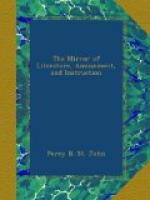O horrible! horrible world! there’s
not e’en
An old maid in’t, to
ask me to tea;
Not fit, or in country or town, to be
seen,
They have hurried off, blindly
to see!
Parks, houses, clubs, shops, churches,
squares, deserts seem;
Quite flat, Magazines and
Newspapers;
Ah, what shall I do? make a trial of steam,
In order to banish the vapours?
Shall I swallow my dinner? I can’t—shall
I sleep?
Then I don’t get away
from myself!
Shall I think what a beau I have once
been, and weep
Like a belle, that is laid
on the shelf?
Shall I write? shall I read? ah, yes,
that will do,
But an old book is terrible
stuff:
Boy, get the new novel, stop, reading’s
so new,
That a book will be
novel enough!
M.L.B.
* * * * *
ANCIENT HISTORY OF DRURY LANE.
(For the Mirror.)
The reader will most probably exclaim, “Ancient History of Drury Lane! What a farce!” A dirty lane filled with all complexions of hawkers and pedlars, licensed and unlicensed!—true incurious reader, Gay has sung
"Of Drury’s mazy courts and dark abodes;"
yet the topographical and theatrical loiterer may call to mind many pleasing reminiscences, although mingled with unpleasing ones:
“Who has not here a watch or snuff-box
lost,
Or handkerchiefs that India’s shuttle
boast.”
GAY.
Stowe says, “Drury Lane, so called, for that there is a house belonging to the family of the Druries.[1] This lane turneth north towards S. Giles in the field. From the south end of this lane in the high street, are divers faire buildings, hostelries, and houses for gentlemen, and men of honor, &c.”
[1] Dr. Donne resided in a
house of Sir R. Drury. Vide Life by
honest
Izaak Walton.
Nightingale tells us, “The west end of Wych Street was formerly ornamented by Drury House, built by Sir William Drury, an able commander in the Irish wars, in the reign of Queen Elizabeth, and who unfortunately fell in a duel with Sir John Burroughs, through a foolish quarrel about precedency. During the time of the fatal discontents of Elizabeth’s favourite, the Earl of Essex, it was the place where his imprudent advisers resolved on such counsels, as terminated in the destruction of him and his adherents. In the next century it was possessed by the heroic Earl of Craven, who rebuilt it. It was lately a large brick pile, concealed by other buildings and was a public-house, bearing the sign of the Queen of Bohemia’s Head, the earl’s admired mistress, whose battles he fought animated by love and duty. When he could aspire to her hand, he is supposed to have succeeded, and it is said, that they were privately married;




